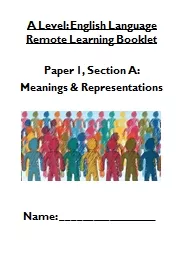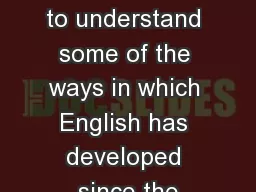PPT-A Level: English Language
Author : CitySlicker | Published Date : 2022-08-03
Remote Learning Booklet Name Paper 1 Section A Meanings amp Representations What does this section of the exam look like One text is older One text is more contemporary
Presentation Embed Code
Download Presentation
Download Presentation The PPT/PDF document "A Level: English Language" is the property of its rightful owner. Permission is granted to download and print the materials on this website for personal, non-commercial use only, and to display it on your personal computer provided you do not modify the materials and that you retain all copyright notices contained in the materials. By downloading content from our website, you accept the terms of this agreement.
A Level: English Language: Transcript
Download Rules Of Document
"A Level: English Language"The content belongs to its owner. You may download and print it for personal use, without modification, and keep all copyright notices. By downloading, you agree to these terms.
Related Documents














